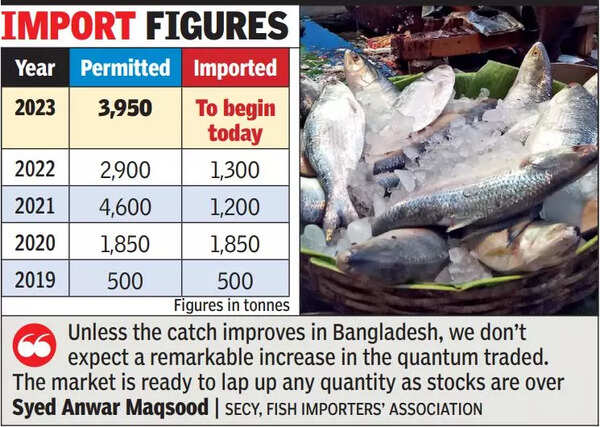[ad_1]

“This is the longest period granted by the Bangladesh government for export of hilsa to India since the ban on exports was imposed in 2012. Till last year, we used to get a 30-day window before Durga Puja for importing the fish. This year, that has been extended to 40 days, which means we will be able to get more fish,” said Fish Importers’ Association secretary Syed Anwar Maqsood.
The permitted quantity is more than 1,000 tonnes higher than last year’s but lower than the 4,600 tonnes allowed in 2021. Though the duration for the trade has been increased by 10 days, Maqsood said it is still inadequate to allow 3,950 tonnes of fish to be traded and expected around 1,200 tonnes of hilsa to reach India. That is less than a third of the approved amount.
Maqsood had written to the Bangladesh commerce minister and Bangladesh deputy high commissioner in Kolkata around a fortnight ago, requesting an extension of the waiver period for hilsa exports to two months instead of one, and even called for lifting of the ban, arguing that India used to import around 5,000 tonnes of hilsa in the whole year prior to 2012.
“Unless the catch improves in Bangladesh harbours, we don’t expect a remarkable increase in the quantum that is traded. The market is ready to lap up any quantity as stocks in the cold storage are over. Whatever was there got sold during Ranna Puja. The local catch has declined. Myanmar hilsa will arrive only around December. So the time is great for consignments from Bangladesh,” Maqsood said.
The initial price of fish in the wholesale market is pegged to be around Rs 1,200-Rs 1,300 per kg for 800g to 1.2kg fish. In the retail market, the price will be higher by around Rs 250-Rs 300 per kg.
The Bangladesh government has permitted 79 hilsa exporters to send 50 tonnes each to India. The time allowed is till October 30, after which hilsa fishing ban will kick in in Bangladesh.
[ad_2]
Source link





Join The Discussion